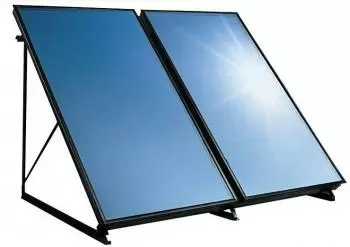
Low temperature solar thermal energy is an innovative and sustainable way to take advantage of solar radiation for multiple applications. This approach uses solar collectors to capture the sun's heat and convert it into useful energy, with more moderate temperatures compared to high-temperature solar energy.
It is used to heat water, spaces, and in agricultural applications, contributing to the reduction of energy costs and carbon emissions. Its benefits include sustainability, low operating costs, versatility and lower environmental impact, making it a promising solution for heat and power generation in various applications.
What is solar thermal energy used for?
The use of low temperature solar thermal energy is used in many applications, of which we highlight the following:
Production of Domestic Hot Water (DHW)
The main application of solar thermal energy is the production of domestic hot water (DHW) for the domestic and service sectors. Domestic hot water is used at a temperature of 45 degrees Celsius. This temperature can be easily reached with flat solar collectors that can reach an average temperature of 80 degrees Celsius.
Low temperature heating
Solar heating systems are a complement to the traditional heating system, especially for systems that use make-up water at less than 60 °C.
For heating with solar input, the system that works best is underfloor heating (a circuit formed by a network of pipes through the floor), since the temperature of the fluid that circulates through this circuit is about 45 °C, easily achievable through solar collectors.
Swimming pool water heating
The use of solar collectors allows energy support in outdoor pools, lengthening the bathing period.
It must be considered that the legislation of some countries does not allow the heating of outdoor pools using conventional energy sources, which are usually non-renewable energy sources.
In this type of installations, solar collectors without glass can be used. These solar panels are simply made up of a large number of tiny metal or plastic tubes arranged in a coil through which water circulates.
Solar radiation collection systems
The solar radiation collection system is made up of solar collectors connected to each other. Its mission is to capture solar energy to transform it into thermal energy, increasing the temperature of the fluid that circulates through the installation.
The most widespread type of thermal collector is the flat solar collector that achieves temperature increases of 60°C at a reduced cost.
The flat solar collector is made up of a metal plate that is heated by solar radiation with its exposure to the Sun (absorber). This plate is black so that it does not reflect incident solar radiation. Normally the solar panel is placed in a box with a glass cover. Water is circulated inside the box through a coil or a circuit of tubes so that heat is transmitted to the fluid through a thermodynamic process.
The effect produced is similar to that of a greenhouse, sunlight passes through the glass plate and heats the blackened plate. Glass is a “solar trap”, as it allows the Sun's radiation to pass through (short wave) but does not let out the thermal radiation emitted by the blackened plate (long wave) and as a consequence, this plate heats up and transmits heat to the liquid. that circulates through the tubes.
There are also vacuum solar collectors on the market. They consist of metal tubes that cover the metal tube that contains the working fluid, leaving a chamber between them that acts as an insulator. They have very high performance, but their cost is also high.
Components of a solar collector
Solar thermal collectors are made up of several key elements:
- Cover : The cover, made of transparent material, plays a vital role in minimizing heat losses and reducing thermodynamic loss.
- Air channel : The air channel acts as a chamber separating the cover from the absorbent plate and can be empty or filled with air or other fluid.
- Absorber plate : The absorber plate is the part of the collector that captures solar energy and converts it into heat. It must have a high absorption capacity for solar radiation and, at the same time, minimize heat emission.
- Tubes or ducts : The tubes are in direct contact with the absorbent plate to maximize heat transfer by thermal conduction. The liquid circulating through these tubes is heated and transports the heat to a storage tank.
- Insulating layer : The insulating layer covers the entire system and prevents heat loss. To achieve optimal insulation, a material with low thermal conductivity is used.
Together, these components allow solar thermal collectors to effectively capture and use solar energy to heat fluids that are then stored and used in water heating systems or industrial and commercial applications.
Benefits of low temperature systems
Low temperature solar thermal energy offers several benefits:
- Sustainability: Uses an inexhaustible and clean energy source: solar radiation.
- Cost reduction: Can reduce heating and hot water expenses in homes and businesses.
- Environmentally friendly: Minimizes greenhouse gas emissions and reduces dependence on fossil fuels.
- Versatility: Applied in water heating systems, space heating, solar cooling and agricultural applications.
- Low Operating Costs: Once installed, low temperature systems are economical to operate and require minimal maintenance.
- Heat storage: You can integrate heat storage systems to maintain energy availability in non-solar hours.
- Energy independence: Users can reduce their dependence on conventional electrical networks.
- Decentralized applications: It can bring energy to remote areas without access to electrical grids.